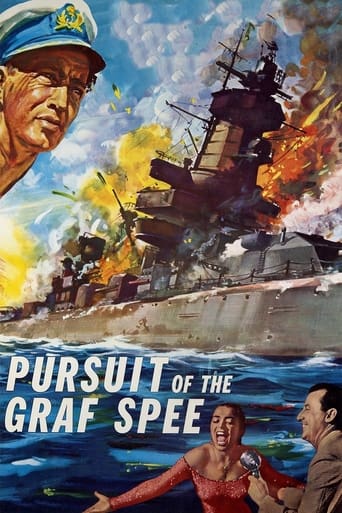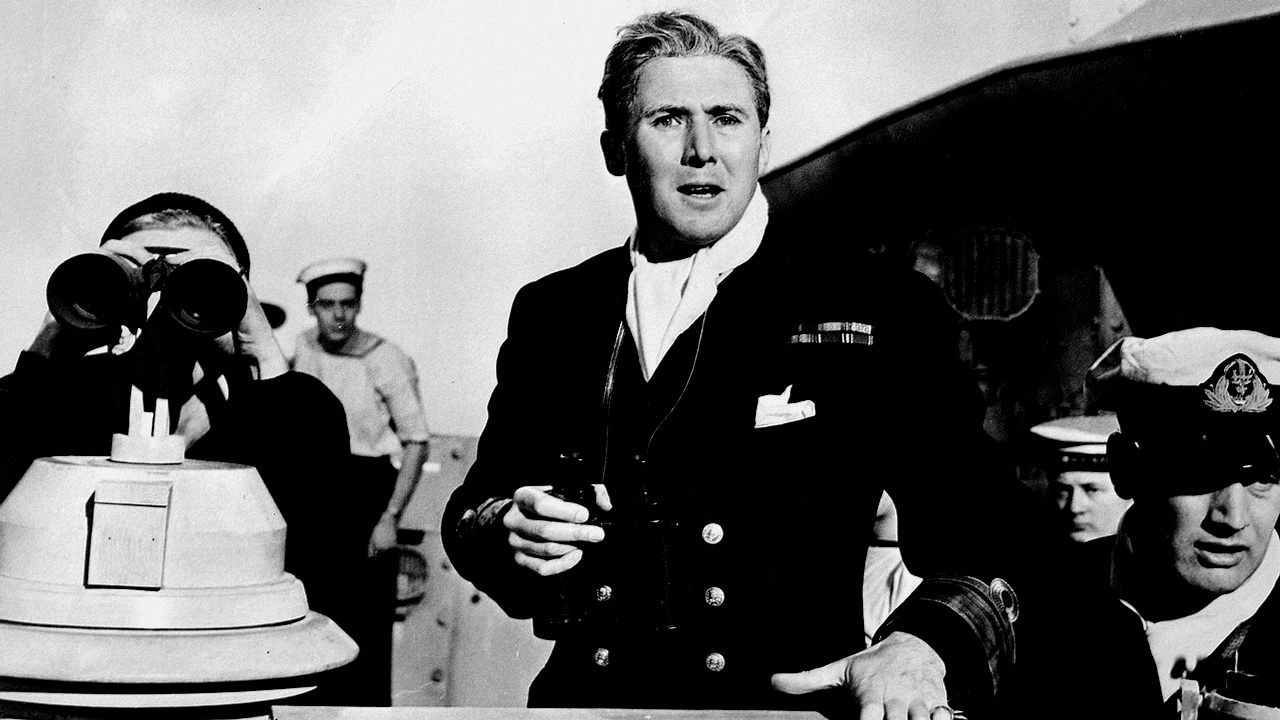matttaylor-65065
I really really like this film. Peter Finch is outstanding as Captain Langsdorf of the German Battleship Admiral Graf Spee. I love the swashbuckling entrance that he makes with Captain Dove (He is the captain of a merchant ship that was sunk by the Admiral Graf Spee). There are so many stand out actors in this film, Christopher Lee, Anthony Quale and John Gregson. The Directors Emeric Pressburger and Michael Powell both work together really well, the cinematography is just amazing, their choice of shots outstanding. Every single character in this film is just outstanding. I think the shots of real ships, that took place during the real battles just makes it for me. I feel like I am on the boat watching action real time! Well worth watching, not to be missed.
deschreiber
The film divides into two parts, the first at sea, the second in the harbour of Montevideo, Uruguay, where the Graf Spee sought shelter after being damaged in battle with two British and one New Zealand warships.The first half suffer badly from what today we call low production values. This is not Tora! Tora! Tora! Apart from a few stock moments of a ship or two at sea, almost everything is done in studio, with very small sets--the bridge, a gun room--and the effect is of complete artificiality. The battle scenes consist of shots of the muzzles of ship's guns firing and, primarily, men in their little studio sets being lit up by orange flashes (the gun flashes, don't you know). When the Graf Spee fires salvos on the British ships, it is indicated by ridiculous splashes of water behind the men standing in their little sets, splashes that look very much like someone throwing a bucket of water into the air. Laughable. It's very hard to take the story seriously. The battle itself is almost entirely depicted with the British men in their little sets, with one or two extremely quick shots of model ships exploding in flames. Add to the low production values lots of very stilted dialogue. British prisoners held on the Graf Spee mutter as a group, then one speaks up and says his line, then another does the same, then a third, then everyone mutters agreement, all as obviously written and rehearsed as a play performed by 10-year-olds.The second part is somewhat of a relief in that it includes lots of outdoor scenes in Montevideo (it might really have been shot there). Still, in the climactic moment when the Graf Spee leaves the harbour, we watch a radio newsreporter tell us what the ship is doing; we don't see it for ourselves.There is more to say about the disappointment of this film. You should be warned, for example, that the battle does not begin until 45 minutes into the film, and the first 45 minutes are not exactly riveting. You need to be prepared, too, for the standard portrayal of Allies facing up to difficulties, all so chipper and not really worried about what might happen to them. It's too bad that a better job wasn't done of this dramatic battle.
robertguttman
This meticulous film re-enacts the first major sea battle of World War II, the dramatic engagement between the German pocket battleship "Graf Spee" and three smaller British cruisers off the coast of South America, and it's equally dramatic aftermath. When the battle-damaged Graf Spee steamed into the neutral Uruguayan port of Montevideo it became front page news all over the world, and everybody wondered how the story would end. Would the Graf Spee allow herself to be interned in Uraguay, would she attempt to escape out to sea, or would she fight the British again? And if she did choose to fight, just how powerful a force did the British have left to face her? At the time the film was produced there were no longer any warships resembling the Graf Spee, so the producers made do with the U.S. Navy's heavy cruiser "USS Salem". The real Graf Spee was actually a great deal more powerful than the USS Salem. The Graf Spee could out-run any warship she didn't out-gun, and she out-gunned any warship she couldn't out-run. For those reasons the Graf Spee was more than a match for the three British warships that faced her. It was as though three terriers were taking on an angry bear.One noteworthy aspect of this film is that the producers listed the ships in the credits as though they were members of the cast. It was entirely appropriate that they should have done so, since this is essentially a story of ships and the seamen who manned them. It is also noteworthy that two of the ships in the cast, HMS Cumberland and HMIS Delhi (formerly HMNZS Achilles) were actually present during the original events. As for the original HMS Exeter, it was a tribute to the professionalism of her crew that she actually survived the tremendous battering depicted in the film (she was hit by seven of Graf Spee's 11-inch shells). Unfortunately she was sunk by the Japanese in 1942, and the survivors of her gallant crew spent the remainder of the war living under conditions similar to those depicted in "The Bridge Over the River Kwai".
hcoursen
The film might have worked had it been conceived as a kind of chess match -- between the British Commodore and Capt. Langsdorff, and incorporating the diplomatic shuffling. But the German point of view was dropped as soon as the first shell was fired. We got scenes aboard Graf Spee only in the prisoners' hold. We needed a parallel scene from Langsdorff's perspective to the one Quayle held with his commanders. The final decision -- to scuttle -- came out of the blue. Hitler's role was not mentioned. Langsdorff's concern for his crew was only implied in the funeral scene. Check me if I'm wrong, but the actual funerals occurred on land, did they not? Langsdorff's suicide was not included -- shocking to someone who knows the history. His motive was complicated, but included, apparently, his wish to silence anyone who would claim that he was a coward for not re-engaging the British flotilla. The film did dramatize the really rudimentary communications available in 1939 -- bugles, shouted commands, signal flags, binoculars. Had Langsdorff had an observation aircraft, as the British are shown to have had, things might have been very different.


 AD
AD



